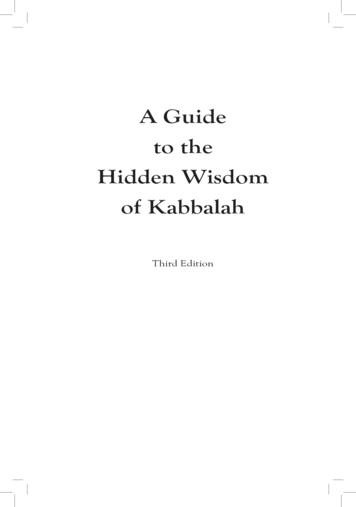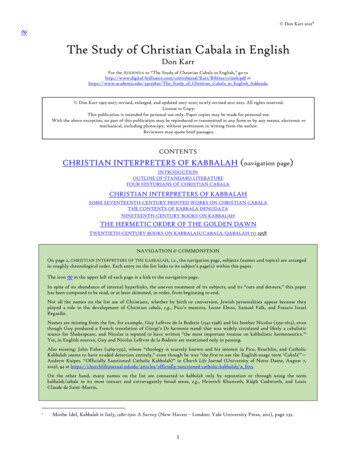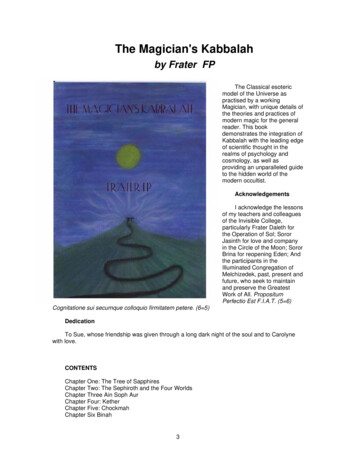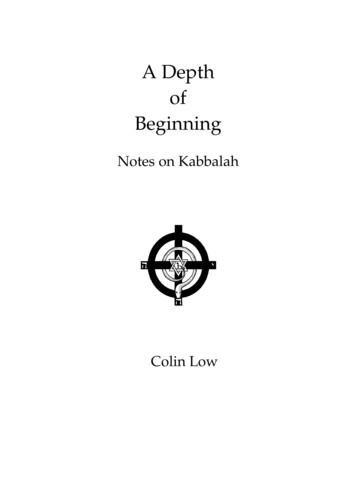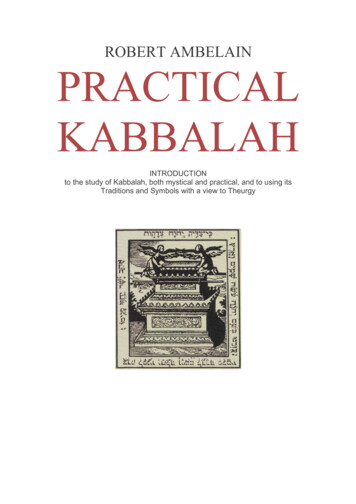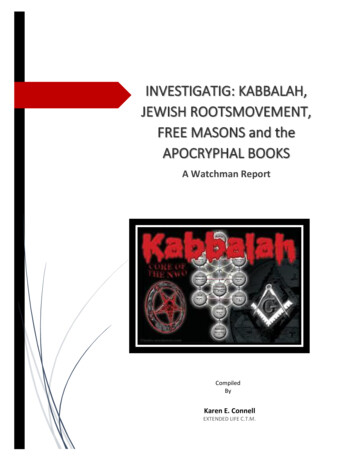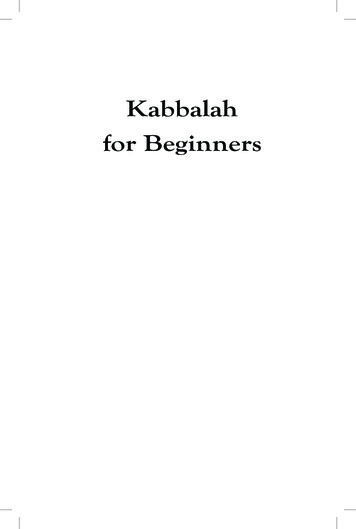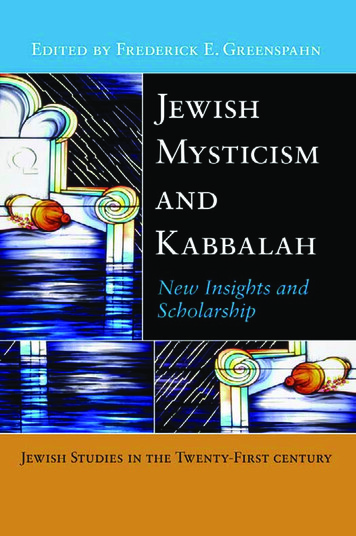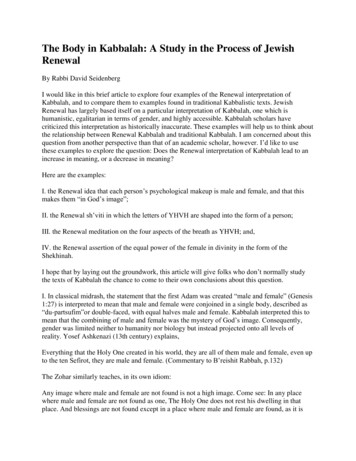
Transcription
The Body in Kabbalah: A Study in the Process of JewishRenewalBy Rabbi David SeidenbergI would like in this brief article to explore four examples of the Renewal interpretation ofKabbalah, and to compare them to examples found in traditional Kabbalistic texts. JewishRenewal has largely based itself on a particular interpretation of Kabbalah, one which ishumanistic, egalitarian in terms of gender, and highly accessible. Kabbalah scholars havecriticized this interpretation as historically inaccurate. These examples will help us to think aboutthe relationship between Renewal Kabbalah and traditional Kabbalah. I am concerned about thisquestion from another perspective than that of an academic scholar, however. I’d like to usethese examples to explore the question: Does the Renewal interpretation of Kabbalah lead to anincrease in meaning, or a decrease in meaning?Here are the examples:I. the Renewal idea that each person’s psychological makeup is male and female, and that thismakes them “in God’s image”;II. the Renewal sh’viti in which the letters of YHVH are shaped into the form of a person;III. the Renewal meditation on the four aspects of the breath as YHVH; and,IV. the Renewal assertion of the equal power of the female in divinity in the form of theShekhinah.I hope that by laying out the groundwork, this article will give folks who don’t normally studythe texts of Kabbalah the chance to come to their own conclusions about this question.I. In classical midrash, the statement that the first Adam was created “male and female” (Genesis1:27) is interpreted to mean that male and female were conjoined in a single body, described as“du-partsufim”or double-faced, with equal halves male and female. Kabbalah interpreted this tomean that the combining of male and female was the mystery of God’s image. Consequently,gender was limited neither to humanity nor biology but instead projected onto all levels ofreality. Yosef Ashkenazi (13th century) explains,Everything that the Holy One created in his world, they are all of them male and female, even upto the ten Sefirot, they are male and female. (Commentary to B’reishit Rabbah, p.132)The Zohar similarly teaches, in its own idiom:Any image where male and female are not found is not a high image. Come see: In any placewhere male and female are not found as one, The Holy One does not rest his dwelling in thatplace. And blessings are not found except in a place where male and female are found, as it is
written: “He blessed them and called their name Adam on the day of creating them.” (1:55b,quoted in Daniel Matt’s Zohar, pp.55-6).The formula that the first human was created “du-partsufim” has been interpreted within theJewish Renewal movement as an expression of a psychological idea about gender: that is, thedivine image in human beings (or a very important aspect of it) is that each one of usindividually contains both “male and female”. This interpretation may sound to some likeKabbalah meets Carl Jung in the New Age. Nonetheless, it has strong roots in the texts. I thinkby applying these ideas to the whole human personality, Renewal deepens the meaning ofKabbalah. It does this in a way that is consistent with the tendency we already find in traditionalKabbalah to always identify more and more levels of meaning with the Sefirot.II. A common Jewish Renewal mapping of God’s name onto the human body connects Yod withthe head, Heh with the shape made by the arms and shoulders, Vav with the trunk or spine, andfinal Heh with the shape made by the two legs and the pelvis. This image, which appears to be ofrecent origin, has become the Renewal sh’viti, or meditation “mandala”.Traditionally, sh’viti figures include names of God, verses, angelic inscriptions. The centralimage is usually the image of the menorah formed out of words, along with the four-letter namewritten horizontally. An example of the Renewal image can be found in the Reconstructionistsiddur Kol Haneshamah. However, I have not yet found a description in a Kabbalistic text thatresembles this idea of God’s image. The nearest example I have come across would be thefollowing from Isaiah Horowitz:The name of YHVH is alluded to in the structure of the human being, from top to bottom andfrom bottom to top. How so? The head is like a Yod. The torso is like a Vav. The ten fingers,five on each hand, are the two Heh’s. Also, the ten toes, five on each foot, are the two Heh’s [andpart of a second YHVH]. (Generations of Man, The House of Israel I, p.114, translated by MilesKrassen)This passage, like many similar examples, goes on to describe how each part of the body is also arepresentation of YHVH, i.e. the face, the structure of each hand, the genitals, etc. The name ofGod is spelled twice in the human body according to this passage, once by the upper body andonce by the lower.The truth within the Kabbalah is not that this or that particular body part is in the shape of a Hehor a Yod, but rather that the pattern of God’s name is found at every level and from every angle.It is a way of seeing many dimensions and many bodies.The Renewal version is far more anthropocentric (in a naïve way) than any image found inKabbalah. That’s because there are many parts of our bodies which traditional Kabbalahassociated with YHVH which also resemble the parts of other animals, but the Renewal sh’vitiallows no such comparison. In other words, if in traditional Kabbalah brain, heart and liverrepresent some combination of Yod, Heh and Vav, then this image can be found in manycreatures, but no other creature looks like that Renewal image of the human skeletal frame.
Historically, Renewal tends to favor simpler, “cleaner” symbols and to idealize the power ofhumanity to transform the world. To me, this is reflected in the language of “paradigm shift”,which implies a modernist way of seeing of spiritual and cultural progress. The Renewal sh’vitiof the human body in the image of God’s name may reflect that way of seeing.The question here however is different: Does this image deepen our theology? My own instinctssay the human-form sh’viti is too simplified and literal to teach us what we need to learn aboutour relationship to the world and to God. It reminds me of other representations of Kabbalahfound within Jewish Renewal and in also New Age Qabbalah (as it is often spelled). Theserepresentations have lost the Protean complexity of a textual hermeneutic and the fractalcomplexity of seeing the letters of God’s name at very level of being. My feeling is that thesh’viti represents a loss of information and meaning.III. The idea of connecting the breath with YHVH is a frequent trope of Jewish Renewalteaching. We meditate on Yod as the body is empty of breath, Heh as the in-breath, Vav as thebody full of breath, and Heh as the out-breath. Here, I want to look at a text that maps YHVHonto the breath in a way that differs from this pattern. The following passage from TiquneyZohar talks about the way in which the breath and body of a bird represent God’s name. (Noticethat we are talking about birds here, so this passage is about all breath, not just human breath.Also, this passage pictures the bird’s body as an image of God in the same fashion as the humanbody is described by the Renewal sh’viti – showing again how the traditional Kabbalistic mapmay be less anthropocentric because of its diversity of images.) Here is the passage:“For the bird of the skies will lead the voice, and the masters of wings will tell a word.” Here this[word] is YHVH, the central pillar. Yod is the head of the bird. Vav is his body. Heh-Heh are thetwo wings, through which he flies upward and rests below. And these two wings are two breaths,Heh-Heh. A breath leaves through Yod; a breath returns/rests through Vav. (Tiquna 45, 82b –thanks to R’ Zalman Schacter-Shalomi for alerting me to the existence of this text.)The correspondence between YHVH and the breath made here is a kind of inverse of theRenewal meditation. It says that the two wings, which are the two Hehs, are also two breaths,and that the in-breathing is through Yod and the out-breathing through Vav, thereby completingGod’s name. So Yod-Heh is the in-breath and Vav-Heh is the out-breath. The state of the body atthe end of each half of the breathing cycle, either empty of breath or full of breath, is not relatedto any part of God’s name.This passage affirms the Renewal idea that breath is an image of God in a way which is, so tospeak, orthogonal to the Renewal mapping of breath into YHVH. While one could regard thedifferences between the two conceptions as a loss of symbolic information, it seems to me in thiscase that the two paradigms are complementary. Holding in mind both these pictures togetherleads to a far more nuanced and complex understanding of the breath than either picture couldcreate on its own. And each picture suggests a slightly different meditation – perhaps one willwork best at one time and another at another time.
However, the synergy of the two mappings of the breath onto YHVH can only happen if weknow about both of them. To draw the most from its teachings, Renewal teachers need to educateour community about these traditional sources along with the Renewal interpretations.IV. The focus in Jewish Renewal kabbalah on the “divine feminine” as a model of genderliberation is the most controversial of all the examples discussed here. It has been heavilycriticized by scholars; Elliot Wolfson, to take the most pre-eminent example, calls the feministand Renewal embrace of Kabbalah “a misreading that I readily endorse as a human being butregrettably reject as a historical scholar.” (“The Mirror of Nature in Medieval JewishMysticism”, delivered at the Harvard conference on Judaism and Nature, 1998.)Wolfson’s criticism is rooted in the approach to the feminine one finds throughout Kabbalah. Ingeneral, Kabbalah understands the feminine to be a limb of the body of the male, or as somethingwhich completes the male. In other words, the feminine within Kabbalah has no feministimplications, since the feminine in her or its redeemed state is assimilated and masculinized. (Seeespecially Elliot Wolfson’s Circle in the Square along with many of his other articles; for a verybrief overview of the problem see my article “The Human Body and the Cosmic Tree” in Trees,Earth, and Torah, pp.270-273).Nonetheless, there seems to be an alternative vision of gender within Kabbalah that we canauthentically draw on without making a false or ahistorical reading of Kabbalah, if we focus onwhat literary critics call “counter-texts”. There are exceptional passages in Lurianic Kabbalah,for example, which suggest that the female unites with the male only after becoming complete inherself:There are two aspects to the female of Z’er Anpin, one when she is contained initially in themale, and the second when she is separated from him and he gives her the crown of strength.When she separates from him and becomes an autonomous aspect, then the two of them are inthe secret of a husband and his wife, the male alone and the female alone.” ( Ets Chayim 10:3,49a-b, cited in Wolfson, p.116. For a book-length treatment of this perspective in LurianicKabbalah see Sarah (Susan) Schneider’s Kabbalistic Writings on the Nature of Masculine andFeminine.)This motif was built upon by a handful of later Jewish works, such as the Chasidic Or Hame’ir(18th century). He explains that the Holy One, or Tif’ eret, “trembles” for the Shekhinah tobecome “body opposite body”, so that the male and female dimensions of divinity can be unitedwith each other. He wrote that we bring redemption by seeking to complete the female aspect ofdivinity:And all this falls upon us, to bring near the time of redemption through means of good acts [sothat] her body [qomah] will be built and established. Know how to raise up, now in this dayespecially, the limbs of the Shekhinah, in order to redeem her from exile, for this is the tendencyof our souls. to build her and to prepare her with a complete body [qomah sh' leymah]. (pp.51-2)Now these passages do not change the fact that the overwhelming message of Kabbalah does notsupport gender liberation. But if it is up to us to “bring near the time of redemption”, then that
also means it is up to us to make new interpretations. To do this, we need to be able to hear inthese texts a teaching about the future of Kabbalah and not only the past. That teaching is that weare supposed to help complete the feminine aspect of divinity so that this can happen. To me thismeans liberating the feminine within Kabbalah. The challenge for Renewal is how to stayconnected to the traditional texts of Kabbalah while doing this.Thinking further about how we use Kabbalah in the Renewal community, my main concern isnot whether we choose this or that interpretation, but that we learn the sources well enough topreserve the richness that is in them. I am also concerned that we be clearer about the differencebetween what is already in the traditional texts, and what we are adding to them in order to makeKabbalah meaningful to our lives.Hermeneutically, we can use careful text study to “retool” the system of Kabbalah and to build afuture for our tradition. Looking at these four examples, I would say that Jewish Renewal hasdone well for its first generation of teaching, but that in the second generation we need to deepenour understanding – both through self-criticism and through new creativity.Rabbi David Seidenberg holds a doctorate in Jewish thought focused on ecology and Kabbalah.He was ordained at the Jewish Theological Seminary and is a member of Ohalah. David teachesthroughout North America on theology, political action and spirituality under the rubric of theMa’on Study Circle. This piece first appeared in New Menorah.
Kabbalah, and to compare them to examples found in traditional Kabbalistic texts. Jewish Renewal has largely based itself on a particular interpretation of Kabbalah, one which is humanistic, egalitarian in terms of gender, and highly accessible. Kabbalah scholars have criticized this interpretation as historically inaccurate.


